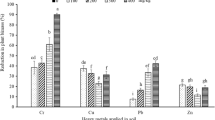Abstract
Phytoremediation, a technique dependent on the heavy metal bioaccumulation and translocation in different parts of plants, is an efficient and environment friendly method for decontamination of soils from metals. In the present study, the bioaccumulation and translocation of heavy metals was analyzed in different parts of cotton plant grown in intensively cultivated agricultural fields of Malwa region of Punjab, India. The soils were found to be alkaline in nature with very high sand contents which resulted in low retention of metals (As, Cr, Cu, Mn, Sr and Zn) in soils. But, the bioaccumulation factor and translocation factor calculated for metal accumulation analysis in cotton plant parts were found to be above 1 (maximum 9.13 for Sr) which indicated that the cotton plant (a non-edible fibre crop) can prove to be a significant system for phytoremediation and an efficient green tool for decontamination of soils from heavy metals.


Similar content being viewed by others
References
Ali H, Khan E, Sajad MA (2013) Phytoremediation of heavy metals—concepts and applications. Chemosphere 91:869–881
Allen SE, Grimshaw HM, Rowland AP (1986) Chemical analysis. In: Moore PD, Chapman SB (eds) Methods in plant ecology. Blackwell, Oxford, pp 285–344
Angelova V, Ivanova R, Delibaltova V, Ivanov K (2004) Bioaccumulation and distribution of heavy metals in fiber crops (flax, cotton and hemp). Ind Crop Prod 19:197–205
Bermudez GMA, Jassan R, Pla R, Pignata ML (2011) Heavy metal and trace element concentrations in wheat grain: assessment of non-carcinogenic health hazard through their consumption. J Hazard Mater 193:264–271
Bhat SA, Singh J, Vig AP (2014) Genotoxic assessment and optimization of pressmud with the help of exotic earthworm Eisenia fetida. Environ Sci Pollut Res 21(3):8112–8123
Bhat SA, Bhatti SS, Singh J, Sambyal V, Nagpal A, Vig AP (2016) Vermiremediation and phytoremediation: eco approaches for soil stabilization. Austin Environ Sci 1(2):1006
Bhatti SS, Sambyal V, Singh J, Nagpal AK (2017) Analysis of soil characteristics of different land uses and metal bioaccumulation in wheat grown around rivers: possible health risk assessment. Environ Dev Sustain 19:571–588
Bhatti SS, Kumar V, Sambyal V, Singh J, Nagpal AK (2018a) Comparative analysis of tissue compartmentalized heavy metal uptake by common forage crop: a field experiment. Catena 160:185–193
Bhatti SS, Sambyal V, Nagpal AK (2018b) Analysis of genotoxicity of agricultural soils and metal (Fe, Mn, and Zn) accumulation in crops. Int J Environ Res 12(4):439–449
Bhatti SS, Kumar V, Kumar A, Gouzos J, Kirby K, Singh J, Sambyal V, Nagpal AK (2018c) Potential ecological risks of metal(loid)s in riverine floodplain soils. Ecotox Environ Safe 164:722–731
Blake GR (1965) Bulk density. In: Black CA (ed) Methods of soil analysis, part I. ASA, Madison, pp 374–390
Blaurock-Busch E, Busch YM, Friedle A, Buerner H, Parkash C, Kaur A (2014) Comparing the metal concentration in the hair of cancer patients and healthy people living in the Malwa region of Punjab, India. Clin Med Insights Oncol 8:1–13
Bremner JM, Mulvaney CS (1982) Nitrogen total. In: Page AL, Miller RH, Keeney DR (eds) Methods of soil analysis. American Society of Agronomy, Madison, pp 575–624
Chandrasekaran A, Ravisankar R, Harikrishnan N, Satapathy KK, Prasad MVR, Kanagasabapathy KV (2015) Multivariate statistical analysis of heavy metal concentration in soils of Yelagiri Hills, Tamilnadu, India—spectroscopical approach. Spectrochim Acta A 137:589–600
Chief Editor Room of Standard Press of China, CERSPC (2009) Compilation of standards for feed industry. Standard Press of China, Beijing (in Chinese)
Clarkson DT, Hanson JB (1980) The mineral nutrition of higher plants. Ann Rev Plant Physiol 31:239–298
Duggal V, Rani A (2018) Carcinogenic and non-carcinogenic risk assessment of metals in groundwater via ingestion and dermal absorption pathways for children and adults in Malwa region of Punjab. J Geol Soc India 92(2):187–194
European Union (2009) Heavy metals in wastes. European Commission on Environment. http://ec.europa.eu/environment/waste/mining/studies/pdf/heavymetalsreport.pdf
Jacob H, Clarke G (2002) Part 4. Physical method. In: Methods of soil analysis. Soil Science Society of America, Madison, p 1692
John MK (1970) Colorimetric determination of phosphorus in soil and plant material with with ascorbic acid. Soil Sci 109:214–220
Kabata-Pendias A, Pendias H (2001) Trace elements in soils and plants, 3rd edn. CRC Press, Boca Raton
Kaur G, Dogra N, Singh S (2018a) Health risk assessment of occupationally pesticide exposed population of cancer prone area of Punjab. Toxicol Sci 165(1):157–169
Kaur B, Singh B, Kaur N, Singh D (2018b) Phytoremediation of cadmium-contaminated soil through multipurpose tree species. Agrofor Syst 92(2):473–483
Kumar R, Kumar R, Mittal S, Arora M, Babu JN (2016) Role of soil physico-chemical characteristics on the present state of arsenic and its adsorption in alluvial soils of two agri-intensive region of Bathinda, Punjab, India. J Soils Sediments 16(2):605–620
Mittal S, Kaur G, Vishwakarma GS (2014) Effect of environmental pesticides on the health of rural communities in the Malwa region of Punjab, India: a review. Hum Ecol Risk Assess 20:366–387
Satpathy D, Reddy MV, Dhal SP (2014) Risk assessment of heavy metals contamination in paddy soil, plants, and grains (Oryza sativa L.) at the east coast of India. Biomed Res Int 2014:1–11
Troeh FR, Thompson LM (2005) Soil and soil fertility, 6th edn. Wiley, New Delhi
Walkley A, Black IA (1934) An examination of Degtjareff method for determination of organic matter and a proposed modification of the chromic acid titration method. Soil Sci 37:29–37
Acknowledgements
The authors acknowledge PG Department of Agriculture, Khalsa College, Amritsar for laboratory facilities.
Author information
Authors and Affiliations
Corresponding authors
Rights and permissions
About this article
Cite this article
Kaur, R., Bhatti, S.S., Singh, S. et al. Phytoremediation of Heavy Metals Using Cotton Plant: A Field Analysis. Bull Environ Contam Toxicol 101, 637–643 (2018). https://doi.org/10.1007/s00128-018-2472-8
Received:
Accepted:
Published:
Issue Date:
DOI: https://doi.org/10.1007/s00128-018-2472-8




